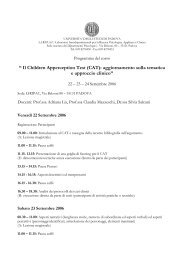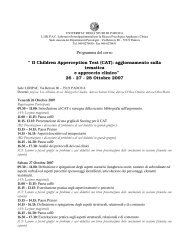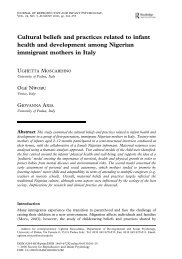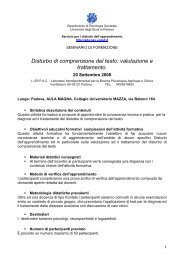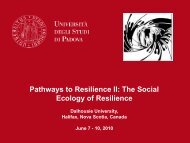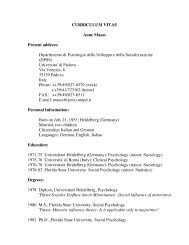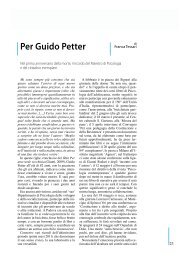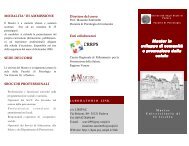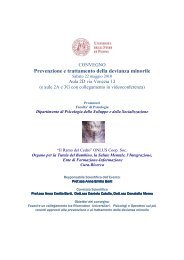Social cognition and moral cognition in bullying: What's ... - DPSS
Social cognition and moral cognition in bullying: What's ... - DPSS
Social cognition and moral cognition in bullying: What's ... - DPSS
Create successful ePaper yourself
Turn your PDF publications into a flip-book with our unique Google optimized e-Paper software.
emotion as an expression of what is right <strong>and</strong> what is wrong <strong>and</strong>, therefore, we expected<br />
this group of children to perform better than any other <strong>in</strong> this type of stories.<br />
F<strong>in</strong>ally, the third aim of the study was to consider the relation between <strong>moral</strong><br />
disengagement <strong>and</strong> bully<strong>in</strong>g behavior (e.g., Caprara et al., 1995; Menes<strong>in</strong>i et al., 1999).<br />
The comparison among pupils who assume different roles may lead to a deeper<br />
underst<strong>and</strong><strong>in</strong>g of the importance of these mechanisms <strong>in</strong> bully<strong>in</strong>g episodes. Specifically,<br />
we expected that the tendency to activate <strong>moral</strong> disengagement mechanisms would be<br />
higher <strong>in</strong> aggressive children (the Bullies <strong>and</strong> their Followers). In contrast, we<br />
hypothesized that Victims <strong>and</strong> those children who frequently <strong>in</strong>tervene to defend their<br />
victimized classmates (Defenders) would show a higher <strong>moral</strong> sensibility <strong>and</strong>,<br />
consequently, a lower level of <strong>moral</strong> disengagement.<br />
Participants<br />
Method<br />
The <strong>in</strong>itial sample comprised 581 Italian primary-school children (295 boys <strong>and</strong><br />
286 girls) aged between 8 <strong>and</strong> 11 years (mean age = 9;7 years, s.d. = 11 months).<br />
Although socio-economic status was not directly measured, our sample <strong>in</strong>cluded<br />
students from a wide range of social backgrounds (low <strong>and</strong> work<strong>in</strong>g classes through<br />
upper middle class). In terms of racial/ethnic background, the sample was predom<strong>in</strong>antly<br />
Caucasian (96%), with a small proportion of Asian (2%) <strong>and</strong> North African (2%) orig<strong>in</strong>.<br />
All children received school <strong>and</strong> parental permission to participate prior to the collection<br />
of the data.<br />
11



